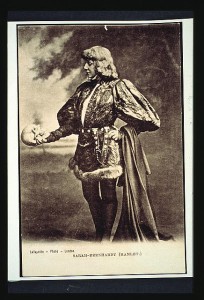Originally printed in the article “Behind the Scenes” from Chambers’s Journal, 1898
Another department of this world of illusion is the property-room, so called because there the various “properties” or “props” are constructed and stored for use. Props comprise all the portable articles required in a play. Guns and pistols — which too often fail to go off at the critical moment — are props; loaves of bread, fowls, fruit, all made of a rough papier-mâché, are also props. We may also include those wondrous gilt goblets, only seen on the stage, which make such a nonmetallic thud when they fall and bounce upon the boards, as among the achievements of the property-man. But it is at pantomime-time that that individual is at his busiest. Big masks and make-believe sausages and vegetables, without which no pantomime would be complete, are mingled with fairy wands, garlands of artificial flowers, basket-work frames for the accommodation of giants, and other articles too numerous to mention. How the right things are forthcoming at the right moment is one of those mysteries only known to property-men. Had one of these useful members of the theatrical world the ability and inclination to write a book, what an entertaining volume could he turn out!
A London or first-class provincial theatre would not perhaps furnish examples of those stage contretemps which are often more amusing to the onlookers than the play itself; but in minor country theatres the most absurd and incongruous make-shifts are often introduced on the score of a very necessary economy. For example, at one country theatre, we remember a “prop” which figured in Act I as a sofa. It was a flat piece of scenery about six feet in length, with scroll edges which represented feet. In Act II this same prop was turned round, and hung upside down by a cord round the hero’s neck. It was painted on the side now presented to the audience like a boat; and as the actor grasped the heroine with one arm, he worked the boat up and down with the other while he proceeded across the stage behind a line of canvas representing a stormy sea. On this touching picture the curtain came down amid uproarious applause. Another occasion we call to mind, upon which a flat piece of scenery was used to represent a very solid object, when the resulting applause was of a more derisive nature. In this piece, a very full-flavoured melodrama, the heroine was in peril of her life by being placed by the villain across a railway track. On came an impossible locomotive, piloted at the back by a scene-shifter invisible to the audience, until by some mishap the engine fell flat on its face like a pancake, amid a roar of laughter from a delighted public. Such accidents as these never occur in a well-equipped theatre. Indeed, the complaint is sometimes made that the scenic illusion is so complete and beautiful that the attention of the audience is unduly distracted from the action of the play.


